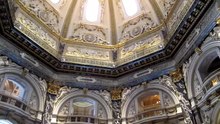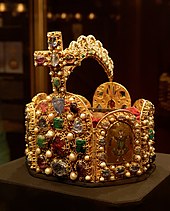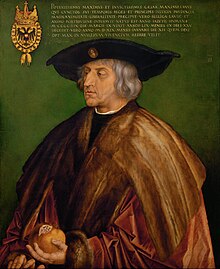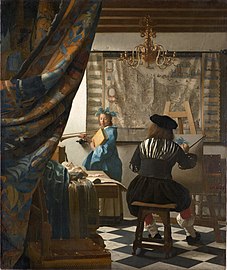Art History Museum
|
|||
|---|---|---|---|

|
|||
| State level | Federal level | ||
| position | see Most visited sights in Vienna | ||
| At sight | Federal Ministry for Art, Culture, Public Service and Sport | ||
| founding | October 17, 1891 | ||
| Headquarters | Burgring , Vienna 1 , Austria | ||
| management | Sabine Haag | ||
| Website | www.khm.at | ||

The Kunsthistorisches Museum ( KHM ) is an art museum in the Austrian capital Vienna . It is one of the largest and most important museums in the world. It was opened in 1891 and visited by approximately 1.75 million people in 2018.
The museum
The Kunsthistorisches Museum, with its sister building, the Natural History Museum opposite , is one of the most important large historical buildings of the Ringstrasse era . Together they enclose Maria-Theresien-Platz (next to the Burgring ), on which the Maria-Theresien-Monument stands. This square covers part of the former glacis between today's Ringstrasse and Zweierlinie and forms an ensemble monument , which is also part of the World Heritage Site Historic Center of Vienna .
history
The museum emerged from the collections of the Habsburgs , above all from the portrait and armor collection of Ferdinand of Tyrol , the collection of Emperor Rudolf II (the majority of which is, however, scattered) and the collection of paintings of Archduke Leopold Wilhelm . As early as 1833, Joseph von Arneth , custodian (and later director) of the imperial coin and antiquity cabinet, requested that all imperial collections be brought together in a single building.
Building history
The order to build the museum was given by Emperor Franz Joseph I , who had decided to demolish the city wall at Christmas 1857, in the course of the city expansion that began in 1858.

As a result, numerous designs for the ring road zone were submitted. Plans by August Sicard von Sicardsburg and Eduard van der Nüll provided for the erection of two museum buildings immediately adjacent to the Hofburg to the left and right of today's Heldenplatz . The architect Ludwig Förster planned museum buildings between Schwarzenbergplatz and the city park . Martin Ritter von Kink preferred buildings on the corner of Währinger Strasse and Schottenring, where the Votive Church was subsequently built . Peter Joseph Lenné suggested the area around Bellariastraße (i.e. not far from the actually chosen location). Moritz von Loehr wanted to build the two court museums on the south side of the Opernring (where the Academy of Fine Arts Vienna was later built), Ludwig Zettl on the south-east side of the Getreidemarkt .
In 1867 a competition was announced for the museums and their current position was determined - at the Emperor's request, the museums should not be built too close to the Hofburg, but across the Ringstrasse. The architect Carl von Hasenauer took part in this competition and was able to get Gottfried Semper , who was then working in Zurich, to work together. The two museum buildings were to be built in the style of the Italian Renaissance . The plans met with the approval of the imperial family. In April 1869 Semper had an audience with the emperor and an oral contract was awarded, in July 1870 the written contract was sent to Semper and Hasenauer.
The decisive factor for the success of Semper and Hasenauer in relation to the projects of other architects was, among other things, Semper's vision of a large building complex called “ Kaiserforum ”, in which the museums would have been a part. Not least because of Semper's death in 1879, the Kaiserforum was not carried out as planned, but the two museums were built.
Construction of the two museums began without any festivities on November 27, 1871. Semper then moved to Vienna. From the beginning there were considerable personal differences between him and Hasenauer, who finally took over the sole construction management from 1877. In 1874 the scaffolding was erected up to the top floor and the mezzanine floor was completed; In 1878 the first windows were installed, in 1879 the attic and the balustrade were completed and in 1880–1881 the dome and the tabernacle were built.
The attic is wreathed with statues depicting personalities from the field of art. The sculptural jewelry was made by Edmund Hellmer , Carl Kundmann , Viktor Tilgner , Caspar Zumbusch and others. The entrance is flanked by seated allegorical statues of painting (left by Edmund Hellmer) and sculpture (right by Johannes Benk ). The dome is crowned with a bronze statue of Pallas Athene by Johannes Benk.
The staircase of the Kunsthistorisches Museum is furnished with works by Gustav Klimt , Ernst Klimt , Franz Matsch , Hans Makart and Mihály Munkácsy .
The lighting and air conditioning concept with double glazing of the ceilings made it possible to dispense with artificial light (at that time mainly gas lighting), but due to this dependence on daylight, it led to seasonal opening times.
Statue of Athena on the dome of the museum
Imperial times

The Kunsthistorisches Museum was officially opened by Emperor Franz Joseph I on October 17, 1891 . The museum has been open to the public since October 22, 1891. Two years earlier, on November 3, 1889, the weapons collection, today the court hunting and armory chamber, opened its doors. On January 1, 1890, the library started its operations. The merging and installation of the other collections of the very highest imperial family from the Lower and Upper Belvedere , the Hofburg and Ambras Palace in Tyrol will take another two years.
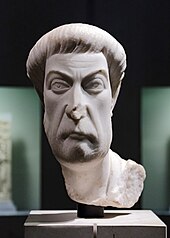
In 1891 the court museum was organized in seven collections with three departments:
- Coins, Medals and Antiquities Collection Directorate
- The Egyptian Collection
- The antique collection
- The coin and medal collection
- Management of the collection of weapons and industrial art objects
- Weapon collection
- Collection of art industrial objects
- Director of the picture gallery and restoration company
- Collection of watercolors, hand drawings, sketches etc.
- Restoration institute
- Library
Very soon the space that the court museum offered for the imperial collections became too small. To remedy this, an exhibition of the ancient finds from Ephesus was designed in the Theseus temple in the Volksgarten. In addition, however, rooms in the Lower Belvedere had to be rented.
In 1914, after the heir to the throne Franz Ferdinand was assassinated , his Estensian collection was transferred to the administration of the court museum. This collection, which emerged from the art collection of the House of Este and the world travel collection of Franz Ferdinand, had been on display in the New Hofburg since 1908 . Today's collection of old musical instruments and the ethnological museum emerged from these holdings .
Except for the oppressive economic situation, the First World War passed without a loss. The court museum remained regularly open to the public during the five years of the war.
Until 1919 the Imperial and Royal Art History Court Museum was under the office of chief treasurer and belonged to the family entrepre- neurship of the House of Habsburg-Lothringen. The officials and employees were part of the imperial court.
First republic
The transition from monarchy to republic took place in the museum in complete calm. On November 19, 1918, the two court museums on Maria-Theresien Platz were placed under the state protection of the young Republic of German Austria . The claims to Austrian art possessions made by the “successor states” of the monarchy as well as Italy and Belgium in the following weeks and months became threatening for the museum's holdings. In fact, on February 12, 1919, 62 paintings were forcibly removed by armed Italian units. This “art theft” left a trauma among curators and art historians for a long time.
It was not until the peace treaty of Saint-Germain of September 10, 1919 that Articles 195 and 196 provided for the regulation of claims in the cultural field by negotiation. The claims of Belgium, Czechoslovakia and, more recently, Italy were largely averted in this way. Only Hungary, which by far made the greatest demands, was granted 147 cases after more than ten years of negotiations.
On April 3, 1919, the House of Habsburg-Lothringen was expropriated by law and its property, including the “Collections of the Erzhaus”, was taken over by the Republic. On June 18, 1920, the provisional administration of the former court museums as well as the Estensian collections and the secular and spiritual treasury was transferred to the State Office for Internal Affairs and Education , and since November 10, 1920 the Federal Ministry of Internal Affairs and Education. A few days later, the Kunsthistorisches Hofmuseum was renamed “Kunsthistorisches Staatsmuseum Wien”, and in 1921 as “Kunsthistorisches Museum”. On January 1, 1921, the employees of the museum were transferred to the normal staff of the republic.
By taking over the former imperial collections in state ownership, the museum found itself in a completely new situation. In order to do justice to the changed conditions in the museum sector, Hans Tietze designed the “Vienna Museum Program ” as early as 1919. It envisaged close cooperation between the individual museums in order to set the focus of collection at the various houses. Exchange, sale and compensation dominated the acquisition policy in the interwar period. This resulted in collection trends that are still valid today. The move of the weapons collection from 1934 to its current premises in the Neue Burg, where the collection of old musical instruments had been set up since 1916, was also trend-setting.
With the change of the imperial collections to the property of the republic, the internal organization was reorganized. From 1919 the museum was divided into the
- Egyptian-oriental collection (with the oriental coins)
- Collection of antiquities
- Collection of ancient coins
- Collection of medals and modern coins
- Weapon collection
- Collection for plastic and applied arts with the collection of old musical instruments
- Picture gallery
The museum 1938–1945

With the “ annexation ” of Austria to the German Reich, all Jewish art collections such as those of the Rothschilds were forcibly “Aryanized” . Collections were either "donated" or simply distributed to the museums by the Gestapo . This resulted in a considerable increase in stocks. However, the KHM was not the only museum that benefited from Aryanization. Stolen Jewish property was systematically sold to museums, collections or pawn shops throughout the Reich.
After the end of the war, the museum found it difficult, as far as it wanted at all, to return the “Aryanized” works of art to the owners or their heirs. The Rothschild family was forced to donate most of their own collection to the museum; this was called “dedication” or “donation”. The reason given was the export law, which did not allow owners to take certain works of art out of the country. Similar methods have been used with other former owners.
Only decades later, due to international diplomatic and media pressure, largely from the United States , did the federal government decide to change the law ( Art Restitution Act of 1998, the so-called Lex Rothschild ). The works of art were not returned to the Rothschild family until the 1990s.
The Kunsthistorisches Museum conducts extensive provenance research on the basis of the Federal Law on the Return of Art Objects of December 4, 1998 (Federal Law Gazette I No. 181/1998) . Even before this decree, provenance research was carried out in-house on the initiative of the archives director at the time, Herbert Haupt. For this purpose, in 1998, with the assistance of Lydia Gröbl, he presented a comprehensive account of the changes in the inventory of the Kunsthistorisches Museum during the Nazi era and in the years up to the 1955 State Treaty , an important basis for further provenance research.
The two historians Susanne Hehenberger and Monika Löscher have been working as provenance researchers at the Kunsthistorisches Museum on behalf of the Commission for Provenance Research since April 1, 2009, and are working on the study period from 1933 to the recent past. As reported in September 2015, the process of coming to terms with the theft of music from the Nazi era is only now beginning. According to Commission Chairman Eva Blimlinger, a report on the collection of old musical instruments is to be submitted by the end of 2017.
The museum today
At the instigation of the then director Wilfried Seipel, the museum became the first federal museum to have full legal capacity on January 1, 1999 . (Most of the other federal museums followed in the years that followed.) With around 880,000 visits to the main building and Neuer Burg (2014, without associated collections that were experienced as independent), it is one of the most popular sights in Vienna .
The Kunsthistorisches Museum as a museum operation has been operating under the name of the Kunsthistorisches Museum mit Museum für Völkerkunde and the Austrian Theater Museum with the commercial register number 182081t since June 11, 1999 on the basis of the Federal Museum Act , Federal Law Gazette I No. 115/1998 , and the museum regulations of the Kunsthistorisches Museum mit Museum für Völkerkunde und Österreichisches Theatermuseum from January 3, 2001, Federal Law Gazette II No. 2/2001, in force since January 1, 2001, defined as a federal scientific institution under public law .
Managing directors with collective signing authority are the commercial managing director Paul Frey and the scientific managing director and general director Sabine Haag . In the second half of 2019, Eike Schmidt was supposed to take over the scientific management of the Kunsthistorisches Museum, but canceled at short notice on October 1, 2019, which is why Sabine Haag's service time was extended interim.
Authorized signatories with collective signing authority are Franz Pichorner, Christian Hölzl, André Alvarado-Dupuy and Verena Maria Hofer.
The members of the Supervisory Board are: Peter Püspök (Chairman), Theodor Öhlinger (Deputy Chairman), Brigitte Borchhardt-Birbaumer, Roswitha Denk, Rudolf Ertl, Josef Kirchberger, Bernhard Mazegger, Johann Pauxberger and Wolfgang Polzhuber.
In the 2008 financial year, sales were 37.185 million euros and the balance sheet total was 22.204 million euros. In 2008, an average of 410 people were employed.
Head since 1919
- 1919–1923: Gustav Glück as First Chairman of the College of Scientific Officials
- 1924–1933: Hermann Julius Hermann 1924–1925 as First Chairman of the College of Scientific Officials , from 1925 as First Director
- 1933: Arpad Weixlgärtner as first director
- 1934–1938: Alfred Stix as first director
- 1938–1945: Fritz Dworschak 1938 as provisional director , from 1938 as director , from 1941 as first director
- 1945–1949: August Loehr 1945–1948 as executive director of the state art collections , from 1949 as general director of the federal government's cultural and historical collections
- 1945–1949: Alfred Stix 1945–1948 as managing director of the state art collections , from 1949 as general director of the federal art history collections
- 1949–1950: Hans Demel as administrative director
- 1950: Karl Wisoko-Meytsky as general director of the federal art and cultural history collections
- 1951–1952: Fritz Eichler as administrative director
- 1953–1954: Ernst H. Buschbeck as administrative director
- 1955–1966: Vinzenz Oberhammer 1955–1959 as Administrative Director , from 1959 as First Director
- 1967: Eduard Holzmair as first director
- 1968–1972: Erwin Auer as first director
- 1973–1981: Friederike Klauner as first director
- 1982–1990: Hermann Fillitz as first director
- 1990: Georg Kugler as interim first director
- 1990–2008: Wilfried Seipel as General Director
- since 2009 Sabine Haag as General Director
From November 2019 Eike Schmidt should have taken over the management, he canceled on October 1, 2019. Haag was then initially extended on an interim basis. In December 2019, the Minister of Culture reappointed her as the definitive General Director of the Kunsthistorisches Museum for five years with effect from January 1, 2020.
Collections
The Kunsthistorisches Museum also includes the collections located in the Neue Burg , the Austrian Theater Museum in the Lobkowitz Palace , the Weltmuseum Wien , the Theseus Temple in the Volksgarten, the treasury in the Hofburg and the Imperial Carriage Museum in an outbuilding of Schönbrunn Palace . A branch is located in Ambras Castle in Innsbruck.
Kunsthistorisches Museum (main building)
- Picture gallery
- Egyptian-oriental collection
- Collection of antiquities
- Kunstkammer Vienna
- Coin Cabinet
- Library
new Castle
- Ephesus Museum
- Collection of old musical instruments
- Court hunting and armory chamber
- archive
Hofburg
- Insignia of the Austrian hereditary homage
- Insignia of the Austrian Empire
- Insignia of the Holy Roman Empire
- Burgundian Heritage and the Order of the Golden Fleece
- Habsburg -Lothringian house treasure
- Spiritual treasury
Schönbrunn Castle
Ambras Castle Innsbruck
Significant exhibits
- Important exhibits in the picture gallery
Giorgione: The Three Philosophers , around 1504
Parmigianino: Self-Portrait in a Convex Mirror , 1523/24
Titian: Portrait of Jacopo de Strada , 1567/68
Caravaggio: David with the head of Goliath , 1606–1607
Caravaggio : Madonna of the Rosary , 1606–1607
The most important exhibits in the Gemäldegalerie include the following:
- Jan van Eyck : Cardinal Niccolò Albergati , around 1435
- Martin Schongauer : Holy Family , 1475-1480
-
Albrecht Dürer :
- All Saints Image ("Landau Altar") , 1509–1516
- Portrait of Johann Kleeberger , 1526
- Parmigianino : Self-Portrait in a Convex Mirror , 1523/24
- Giuseppe Arcimboldo : Summer , 1563
- Michelangelo Merisi da Caravaggio : Madonna of the Rosary 1606/07
-
Titian :
- Nymph and Shepherd , around 1570–1575
- Portrait of Jacopo de Strada , 1567/68
-
Raffaello Santi :
- Madonna in the Green , 1505/06
-
Lorenzo Lotto :
- Portrait of a youth in front of a white curtain , 1508
-
Peter Paul Rubens :
- The altar of St. Ildefonso , 1630-1632
- The little fur , around 1636/1638
- Jan Vermeer : The Art of Painting , around 1666/1668
-
Pieter Bruegel the Elder : The Kunsthistorisches Museum has the painter's largest collection with twelve Bruegel paintings.
- Fight between Mardi Gras and Lent , 1559
- Children's games , 1560
- Saul's suicide , 1562
- Tower of Babel , 1563
- Christ Carrying the Cross , 1564
- Gloomy day (early spring) , 1565
- Return of the Herd (Autumn), 1565
- Hunters in the Snow (Winter), 1565
- Farmer and bird thief , 1568
- Peasant wedding , 1568/69
- Peasant dance , around 1568
- Conversion of Pauli , 1567
- Room X: Painting by Pieter Bruegel the Elder Ä.
Kunstkammer:
- Saliera by Benvenuto Cellini 1539–1543
Egyptian-oriental collection:
Antique collection:
Trivia
- The Saliera by Benvenuto Cellini , one of the most valuable sculptures of the museum, was stolen on May 11 in 2003 during renovations. With the help of the convicted perpetrator, she was found on January 21, 2006 in a forest near Zwettl .
- The Kunsthistorisches Museum was virtually reconstructed by Illusion Softworks for the computer game Mafia: The City of Lost Heaven .
- On the roof of the Kunsthistorisches Museum is the statue of Pallas Athene , goddess of the arts and sciences. Opposite, on the roof of the Natural History Museum, is Helios .
- In 2014, the Austrian film artist Johannes Holzhausen produced a 94-minute documentary film about the Kunsthistorisches Museum, which was released in September 2014 under the title “The Great Museum”.
- The Kunsthistorisches Museum is the setting of the novel Old Masters by Thomas Bernhard . Every other day, the protagonist sits in front of Jacopo Tintoretto's white-bearded man for hours . One episode concerns the painting Landscape in Suffolk by Thomas Gainsborough .
Movies
- Museum check with Markus Brock : Kunsthistorisches Museum Vienna. Synopsis and video from 3sat. First broadcast: December 14, 2014
literature
History of the Kunsthistorisches Museum
- Theodor von Frimmel: gallery studies. History of the Vienna Painting Collections 1. The Imperial Painting Collection. Vienna 1892.
- Theodor von Frimmel: How they spoiled the Viennese gallery. Vienna 1892.
- Heinrich Zimmermann, Anton Handlirsch, Ottokar Smital: The two court museums and the court library. The development of the collections, their characteristics and importance. Vienna 1920.
- Alphons Lhotsky: The History of the Collections. Festschrift of the Kunsthistorisches Museum to celebrate the 50th anniversary. Second part. 2 vol. Vienna 1941–1945.
- Herbert Haupt: The Art History Museum. The history of the Haus am Ring. A hundred years as reflected in historical events. Brandstätter, Vienna 1991, ISBN 3-85447-409-1 .
- Beatrix Kriller, Georg Kugler: Museum of Art History. Architecture and equipment. Idea and reality of the total work of art. Brandstätter, Vienna 1991, ISBN 3-85447-410-5 .
- Herbert Haupt: Years of Endangerment. The Art History Museum 1938–1945. Kunsthistorisches Museum, Vienna 1995. ISBN 3-900325-54-5 .
- Herbert Haupt: Hit, but not destroyed. The Kunsthistorisches Museum in the war year 1945. A chronology of the events in pictures. Brandstätter, Vienna 2005. ISBN 3-902510-07-2 .
- Cäcilia Bischoff: The Art History Museum. Building history, architecture, decoration. Brandstätter, Vienna 2008.
- Elisabeth Hassmann, Heinz Winter: Numophylacium Imperatoris. The Vienna Münzkabinett in the 18th century (writings of the Kunsthistorisches Museum 14). Vienna 2016, ISBN 978-3-7001-7841-5 .
Individual collections and collection catalogs
- Hermann Fillitz , Georg Johannes Kugler: Kunsthistorisches Museum, Vienna. Guide to the collections . Vienna 1988.
- Sylvia Ferino-Pagden, Wolfgang Prohaska, Karl Schütz: The picture gallery of the Kunsthistorisches Museum in Vienna. Directory of paintings. Vienna 1991, ISBN 3-85447-365-6 .
- Stephan Tourmalin: The collection of old musical instruments of the Kunsthistorisches Museum . Mandelstamm, Vienna 2018, ISBN 978-3-85476-821-0 .
Web links
- Web presence of the Kunsthistorisches Museum Vienna
- Architecture of the Art History Museum
- Castle Authority Austria - Museum of Art History
- Entry on Kunsthistorisches Museum in the Austria Forum (in the AEIOU Austria Lexicon )
- Literature from and about the Kunsthistorisches Museum in the catalog of the German National Library
- The staircase of the KHM: architecture, painting
- Yearbook of the Art History Collections of the Very Highest Imperial House - digital
- Federal Geological Institute : Kunsthistorisches Museum - Vienna
Individual evidence
- ↑ Most visited sights in Vienna
- ↑ Kunsthistorisches Museum: Object description Eutropios
- ↑ Sophie Lillie : What Once Was. Handbook of the expropriated art collections of Vienna. Czernin, Vienna 2006.
- ↑ Thomas Trenkler: The Rothschild case: Chronicle of an expropriation . Czernin, Vienna 1999.
- ↑ Barbara Tóth: Historic discord. In: Falter weekly newspaper . No. 39/2015, Vienna 2015, p. 19.
- ↑ Eike Schmidt takes over KHM at wien.orf.at, accessed on September 1, 2017
- ^ ORF report on Sabine Haag from September 1, 2017
- ↑ a b Sabine Haag remains KHM boss. In: ORF.at . December 20, 2019, accessed December 20, 2019 .
- ^ ORF report on Eike Schmidt from September 1, 2017
- ↑ News from October 1, 2019
- ^ Website for the film "The Great Museum". Retrieved October 1, 2014 .
- ↑ The work - Old Masters. Comedy (1985) , accessed on February 16, 2016
Coordinates: 48 ° 12 ′ 13.2 ″ N , 16 ° 21 ′ 41 ″ E

